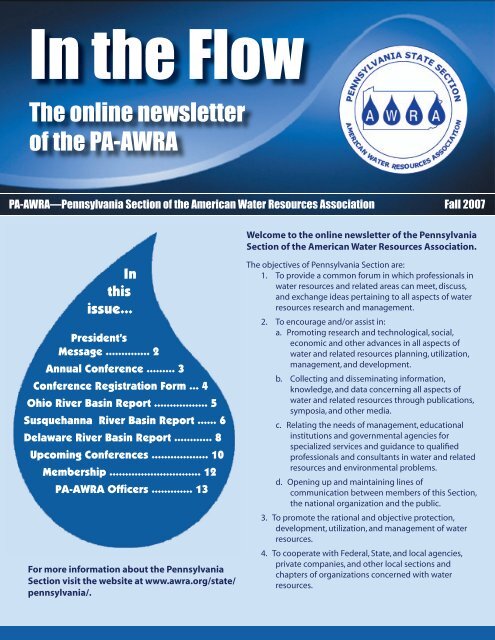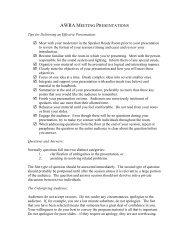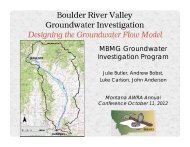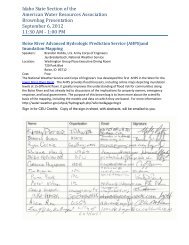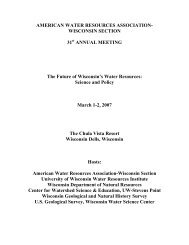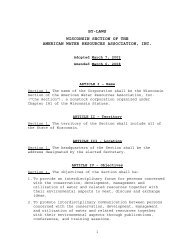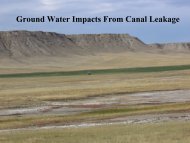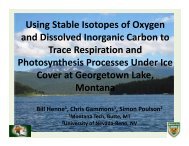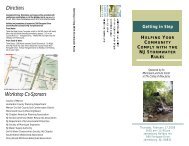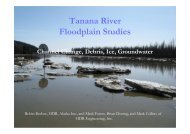The online newsletter of the PA-AWRA - American Water Resources ...
The online newsletter of the PA-AWRA - American Water Resources ...
The online newsletter of the PA-AWRA - American Water Resources ...
Create successful ePaper yourself
Turn your PDF publications into a flip-book with our unique Google optimized e-Paper software.
In <strong>the</strong> Flow<br />
<strong>The</strong> <strong>online</strong> <strong>newsletter</strong><br />
<strong>of</strong> <strong>the</strong> <strong>PA</strong>-<strong>AWRA</strong><br />
<strong>PA</strong>-<strong>AWRA</strong>—Pennsylvania Section <strong>of</strong> <strong>the</strong> <strong>American</strong> <strong>Water</strong> <strong>Resources</strong> Association Fall 2007<br />
In<br />
this<br />
issue...<br />
President’s<br />
Message .............. 2<br />
Annual Conference ......... 3<br />
Conference Registration Form ... 4<br />
Ohio River Basin Report ................. 5<br />
Susquehanna River Basin Report ...... 6<br />
Delaware River Basin Report ............ 8<br />
Upcoming Conferences .................. 10<br />
Membership ............................. 12<br />
<strong>PA</strong>-<strong>AWRA</strong> Offi cers ............. 13<br />
For more information about <strong>the</strong> Pennsylvania<br />
Section visit <strong>the</strong> website at www.awra.org/state/<br />
pennsylvania/.<br />
Welcome to <strong>the</strong> <strong>online</strong> <strong>newsletter</strong> <strong>of</strong> <strong>the</strong> Pennsylvania<br />
Section <strong>of</strong> <strong>the</strong> <strong>American</strong> <strong>Water</strong> <strong>Resources</strong> Association.<br />
<strong>The</strong> objectives <strong>of</strong> Pennsylvania Section are:<br />
1. To provide a common forum in which pr<strong>of</strong>essionals in<br />
water resources and related areas can meet, discuss,<br />
and exchange ideas pertaining to all aspects <strong>of</strong> water<br />
resources research and management.<br />
2. To encourage and/or assist in:<br />
a. Promoting research and technological, social,<br />
economic and o<strong>the</strong>r advances in all aspects <strong>of</strong><br />
water and related resources planning, utilization,<br />
management, and development.<br />
b. Collecting and disseminating information,<br />
knowledge, and data concerning all aspects <strong>of</strong><br />
water and related resources through publications,<br />
symposia, and o<strong>the</strong>r media.<br />
c. Relating <strong>the</strong> needs <strong>of</strong> management, educational<br />
institutions and governmental agencies for<br />
specialized services and guidance to qualifi ed<br />
pr<strong>of</strong>essionals and consultants in water and related<br />
resources and environmental problems.<br />
d. Opening up and maintaining lines <strong>of</strong><br />
communication between members <strong>of</strong> this Section,<br />
<strong>the</strong> national organization and <strong>the</strong> public.<br />
3. To promote <strong>the</strong> rational and objective protection,<br />
development, utilization, and management <strong>of</strong> water<br />
resources.<br />
4. To cooperate with Federal, State, and local agencies,<br />
private companies, and o<strong>the</strong>r local sections and<br />
chapters <strong>of</strong> organizations concerned with water<br />
resources.
In <strong>the</strong> Flow<br />
Fall 2007<br />
In <strong>the</strong> Flow is published<br />
<strong>online</strong> twice yearly<br />
(spring and fall) by <strong>the</strong><br />
Pennsylvania State Section<br />
<strong>of</strong> <strong>the</strong> <strong>American</strong> <strong>Water</strong><br />
<strong>Resources</strong> Association.<br />
If you would like to be<br />
added to or deleted from<br />
<strong>the</strong> <strong>newsletter</strong> mailing list<br />
please notify <strong>the</strong> editor:<br />
Editor, Patricia Craig<br />
E-mail: plc103@psu.edu<br />
Penn State Institutes <strong>of</strong> <strong>the</strong><br />
Environment<br />
125 Land and <strong>Water</strong><br />
Research Building<br />
University Park, <strong>PA</strong> 16802<br />
Telephone: 814.863.0037<br />
Did you<br />
remember to<br />
renew your<br />
membership???<br />
© 2007 <strong>The</strong> Pennsylvania State<br />
Section <strong>of</strong> <strong>the</strong> <strong>American</strong> <strong>Water</strong><br />
<strong>Resources</strong> Association<br />
2 | In <strong>the</strong> Flow<br />
PRESIDENT’S MESSAGE<br />
In our Spring <strong>newsletter</strong>, I wrote <strong>of</strong> <strong>the</strong> prominence <strong>of</strong> energy and power-related<br />
initiatives in Pennsylvania, and <strong>the</strong>ir undisputed link to water resources. <strong>The</strong><br />
quest to develop cleaner, alternative and renewable energy sources is among <strong>the</strong><br />
initiatives attracting <strong>the</strong> most interest – driven not only by threatened scarcity<br />
<strong>of</strong> traditional fuels, but also by <strong>the</strong> desire to reduce carbon emissions to <strong>the</strong><br />
atmosphere.<br />
<strong>The</strong> Union <strong>of</strong> Concerned Scientists (UCS) recently published information about<br />
potential climate changes due to carbon dioxide and o<strong>the</strong>r greenhouse gases.<br />
<strong>Water</strong> resources are obviously an integral part <strong>of</strong> <strong>the</strong> Earth’s climate, and any<br />
changes to Pennsylvania’s climate could likewise have implications for <strong>the</strong><br />
Commonwealth’s water resources. For example, <strong>the</strong> UCS report cites predictions<br />
for an increase in winter precipitation, but with more rain and less snow due to<br />
increased average temperatures. It also points to data predicting an increase in<br />
<strong>the</strong> frequency and severity <strong>of</strong> heavy rainfall – raising <strong>the</strong> likelihood <strong>of</strong> fl ooding<br />
– and, at <strong>the</strong> opposite extreme, an increase in <strong>the</strong> frequency <strong>of</strong> summer droughts.<br />
It is important that we, as water resource pr<strong>of</strong>essionals, know how such changes<br />
are affecting long-term hydrologic patterns.<br />
Fur<strong>the</strong>r complicating <strong>the</strong> matter is <strong>the</strong> reliability <strong>of</strong> hydrologic data. When<br />
planning for water resource management, we typically avail ourselves <strong>of</strong><br />
valuable streamfl ow records stretching back one hundred years or more. But<br />
are we certain that those records still reliably refl ect current conditions or<br />
expected changing conditions? An investigation <strong>of</strong> streamfl ow records at<br />
several long-term gages in <strong>the</strong> Susquehanna River Basin already shows a distinct<br />
difference in patterns pre- and post-1970. Whe<strong>the</strong>r that shift is in response to<br />
warmer temperatures, changes in rainfall distribution, construction <strong>of</strong> large<br />
impoundments that alter fl ow regimes, changes to impervious cover and<br />
stormwater run<strong>of</strong>f, or some o<strong>the</strong>r cause is not yet known.<br />
Whatever <strong>the</strong> cause, <strong>the</strong> implications for water resources <strong>of</strong> climate change could<br />
be extensive, and management, planning and protection cannot occur without<br />
a good understanding <strong>of</strong> what <strong>the</strong> new natural patterns are, or how <strong>the</strong>y are<br />
expected to change. Also, although most focus has been on water quantity,<br />
<strong>the</strong>re is <strong>the</strong> potential for impacts to management <strong>of</strong> water quality as well. For<br />
example, Pennsylvania’s Chesapeake Bay Tributary Strategy will be implemented<br />
using assumptions about <strong>the</strong> entry <strong>of</strong> nutrients into Pennsylvania streams<br />
and how <strong>the</strong>y interact with natural systems, but those assumptions may vary<br />
depending on factors such as average fl ows and water temperatures.<br />
To learn more about <strong>the</strong> UCS publication, visit www.climatechoices.org. If<br />
you’re interested in learning more about water resources in Pennsylvania, I<br />
invite you to attend our annual fall conference, scheduled for October 12th<br />
in Harrisburg. This year’s <strong>the</strong>me is focused on water quality and aspects <strong>of</strong> its<br />
regulation and impairment. Plus, <strong>the</strong> conference will feature a keynote address<br />
on <strong>the</strong> aforementioned Chesapeake Bay Tributary Strategy by leaders from <strong>the</strong><br />
Department <strong>of</strong> Environmental Protection. We hope you’ll consider joining us!<br />
Andrew Deh<strong>of</strong>f
<strong>PA</strong>-<strong>AWRA</strong> Annual Conference Reminder!<br />
<strong>The</strong> annual <strong>PA</strong>-<strong>AWRA</strong> Conference is scheduled for Friday, October 12, 2007 in <strong>the</strong> Wildwood Conference<br />
Center at <strong>the</strong> Harrisburg Area Community College, Harrisburg, <strong>PA</strong>. Cost is $60.00 and can ei<strong>the</strong>r be mailed to<br />
Dale Glatfelter at <strong>PA</strong>-<strong>AWRA</strong>, Gannett Fleming, Inc., P.O. Box 67100, Harrisburg, <strong>PA</strong> 17106-7100; or you can<br />
register at <strong>the</strong> door.<br />
A registration form is provided in this <strong>newsletter</strong>. <strong>The</strong> form is also available on <strong>the</strong> <strong>PA</strong>-<strong>AWRA</strong> website: http://<br />
www.awra.org/state/pennsylvania/conference/annual_conf.htm.<br />
Conference Agenda<br />
8:00 AM Registration<br />
8:45 AM Welcome and <strong>The</strong>me Development, Andrew Deh<strong>of</strong>f , President, <strong>PA</strong>-<strong>AWRA</strong><br />
9:00 AM Keynote Address – “Application <strong>of</strong> Chesapeake Bay Implementation Plan” -John Hines,<br />
Pennsylvania Department <strong>of</strong> Environmental Protection<br />
9:45 AM Refreshment Break<br />
Session 1 – <strong>The</strong> Role <strong>of</strong> <strong>Water</strong> Quality in Regulatory Actions<br />
10:00 AM “NPDES Permitting <strong>of</strong> Wastewater Treatment Plants” - Nick Sahd, Gannett Fleming, Inc.<br />
10:30AM “Implications <strong>of</strong> Recent Rulings on Clean <strong>Water</strong> Act Section 316(b)” - Rick Sands, URS Corp.<br />
11:00 AM “Delaware River Special Protected <strong>Water</strong>s Program” - Kenneth Najjar, Delaware River Basin Commission<br />
11:30 AM “Use <strong>of</strong> Wadesville Pool by Exelon’s Limerick Generating Station” - Craig Wyler, Exelon<br />
12:00 PM <strong>PA</strong>-<strong>AWRA</strong> Annual Business Meeting<br />
12:15 PM Lunch<br />
Session 2 – Managing <strong>Water</strong> Quality Impairment<br />
1:15 PM “Reconnaissance Sampling for Emerging Contaminants in Pennsylvania” - Andrew Reif, USGS <strong>PA</strong> <strong>Water</strong> Science<br />
Center - Exton Project Offi ce<br />
1:45 PM “Acid Mine Drainage on <strong>the</strong> West Branch Susquehanna River” - Pam Milavec, Bureau <strong>of</strong> Abandoned Mine<br />
Reclamation, <strong>PA</strong> DEP<br />
2:15 PM “<strong>Water</strong> Quality Impairments to Pennsylvania’s Groundwater” - Robert Pody, Susquehanna River Basin<br />
Commission<br />
2:45 PM “Studying Legacy Sediments in Pennsylvania" - Jeffrey Hartranft, <strong>PA</strong> DEP<br />
3:15 PM Closing Comments, Ben Pratt , Vice President, <strong>PA</strong>-<strong>AWRA</strong><br />
3:30 PM Adjourn<br />
In <strong>the</strong> Flow | 3
Registration Form: <strong>PA</strong>-<strong>AWRA</strong> 2007 Annual Conference<br />
Conference <strong>The</strong>me: “<strong>Water</strong> Quality Management and Regulation in Pennsylvania”<br />
Date: Friday, October 12, 2007<br />
Location: Wildwood Conference Center at Harrisburg Area Community College;<br />
Harrisburg, Pennsylvania<br />
Registration Information:<br />
Name:<br />
Employer or Organization Affiliation:<br />
Address:<br />
City: State: Zip Code:<br />
Telephone: E-mail Address:<br />
4 | In <strong>the</strong> Flow<br />
$55 Advanced Registration<br />
$60 Late/At-Door Registration (after 10/5/2007)<br />
$25 Student Registration<br />
Please make check payable to Pennsylvania Section <strong>AWRA</strong>.<br />
Mail to: Dale Glatfelter, Secretary/Treasurer<br />
<strong>PA</strong>-<strong>AWRA</strong><br />
Gannett Fleming, Inc.<br />
P.O. Box 67100<br />
Harrisburg, <strong>PA</strong> 17106-7100<br />
To register by E-mail, send <strong>the</strong> necessary information to dglatfelter@gfnet.com, and <strong>the</strong>n ei<strong>the</strong>r send<br />
a check at a later date or pay at <strong>the</strong> door during registration.
<strong>The</strong>re is a need for accurate georeferenced<br />
bathymetric data <strong>of</strong><br />
lakes and reservoirs throughout<br />
Pennsylvania. Data collected<br />
through this effort could be merged<br />
with recently acquired LIght<br />
Detection And Ranging (LIDAR)<br />
land-surface-elevation data to<br />
create a seamless elevation data<br />
set. However, conducting highly<br />
accurate bathymetric surveys<br />
using conventional surveying<br />
and fathometer methods is time<br />
consuming. Recent advances<br />
in equipment, data-collection<br />
techniques, and supported<br />
differential global positioning service<br />
make it possible to produce highly<br />
accurate digital products <strong>of</strong> lake-bed<br />
elevations within a relatively short<br />
period <strong>of</strong> time.<br />
<strong>The</strong> Pennsylvania Department <strong>of</strong><br />
Conservation and Natural <strong>Resources</strong><br />
(<strong>PA</strong> DCNR) and <strong>the</strong> United States<br />
Geological Survey (USGS) have<br />
partnered to acquire geo-referenced<br />
bathymetry for selected Pennsylvania<br />
lakes and reservoirs. <strong>The</strong> program<br />
will initially focus on western lakes<br />
and reservoirs. <strong>The</strong> frequency and<br />
number <strong>of</strong> echosoundings collected<br />
for a given water body will depend<br />
on <strong>the</strong> complexity <strong>of</strong> its bathymetry<br />
and its areal size. For example, a<br />
100-acre lake may require 100foot<br />
spacings. <strong>The</strong> raw bathymetry<br />
data will be processed to fi lter (1)<br />
multiple-return acoustic signals in<br />
shallow water, (2) corrupt GPS signals<br />
(multipathing), and (3) redundant<br />
areas along <strong>the</strong> banks caused by<br />
equipment limitations (Figure 1).<br />
OHIO RIVER BASIN REPORT<br />
Submitted by Thomas Ruby III,<br />
Hydrologist USGS, Ohio River Basin<br />
Bathymetric Surveys <strong>of</strong> Pennsylvania’s<br />
Lakes and Reservoirs<br />
Analog printouts <strong>of</strong> <strong>the</strong> bottom<br />
pr<strong>of</strong>i les will be produced and used as<br />
a quality-assurance measure during<br />
<strong>the</strong> processing phase.<br />
<strong>The</strong> instruments used to defi ne <strong>the</strong><br />
lake bottom are a single-beam, 210<br />
kHz echosounder and differentially<br />
corrected-global positioning system<br />
(DGPS). <strong>The</strong> data will be integrated<br />
with a navigational s<strong>of</strong>tware<br />
package to collect georeferenced<br />
bathymetric<br />
data at predefi ned cross<br />
sections. Differential<br />
corrections will be provided<br />
by a commercially available<br />
service. <strong>The</strong> installation <strong>of</strong><br />
temporary staff gages at<br />
several locations adjacent<br />
to <strong>the</strong> lake will be used to<br />
correlate <strong>the</strong> lake bathymetry<br />
with <strong>the</strong> land surface. <strong>The</strong><br />
vertical elevation <strong>of</strong> <strong>the</strong><br />
staff gages will be surveyed<br />
using a two- meter fi xed<br />
height tripod with Ashtech<br />
Z-12 receivers and Ashtech<br />
Geodetic III “Whopper” Rev D.<br />
L1 and L2 antennas (Figure 2). Data<br />
reduction will be accomplished using<br />
Ashtech’s AOS s<strong>of</strong>tware.<br />
At <strong>the</strong> conclusion <strong>of</strong> <strong>the</strong> data<br />
collection phase, it is anticipated<br />
that digital-bed elevations will be<br />
generated along with a USGS Data<br />
Series report, which will be used to<br />
transmit <strong>the</strong> data and <strong>the</strong> results <strong>of</strong><br />
<strong>the</strong> program.<br />
In <strong>the</strong> Flow | 5
In 1992, <strong>the</strong> Susquehanna River Basin<br />
Commission (SRBC) temporarily<br />
suspended <strong>the</strong> application <strong>of</strong> its<br />
consumptive water use regulations<br />
for agricultural operations. In <strong>the</strong><br />
15 years since, SRBC has worked<br />
with <strong>the</strong> agricultural community<br />
to fi nd solutions for: (1) applying<br />
<strong>the</strong> regulations equitably; and (2)<br />
compliance with <strong>the</strong> consumptive<br />
use regulations, particularly as <strong>the</strong>y<br />
apply to compensation during<br />
periods <strong>of</strong> low fl ow.<br />
Using funds from <strong>the</strong> Pennsylvania<br />
General Assembly, SRBC<br />
conducted two major efforts in<br />
<strong>the</strong> Commonwealth<br />
to fi nd solutions.<br />
<strong>The</strong> fi rst involved<br />
<strong>the</strong> study <strong>of</strong> <strong>the</strong><br />
George B. Stevenson<br />
Reservoir in Cameron<br />
County for possible<br />
water storage. <strong>The</strong><br />
project was deemed<br />
not feasible due to<br />
expected costs in<br />
excess <strong>of</strong> $43 million.<br />
<strong>The</strong> second involved<br />
<strong>the</strong> Pennsylvania<br />
Agricultural<br />
Consumptive<br />
<strong>Water</strong> Use Study.<br />
Under this study,<br />
which concluded<br />
in fall 2005, SRBC<br />
projected agricultural<br />
consumptive water<br />
use through 2025<br />
and reviewed various<br />
compensation options<br />
for <strong>the</strong> consumptive<br />
use.<br />
6 | In <strong>the</strong> Flow<br />
SUSQUEHANNA RIVER BASIN REPORT<br />
Submitted by Damian M. Zampogna,<br />
Basin Director, <strong>PA</strong>-<strong>AWRA</strong>, Susquehanna River Basin<br />
Barnes and Tucker Mine <strong>Water</strong> Treatment Project Will<br />
Improve Environment and Support Farmers<br />
Project is major step toward relieving <strong>PA</strong> farmers <strong>of</strong> consumptive water use<br />
requirements<br />
<strong>The</strong> study identifi ed as a potential<br />
compensation option <strong>the</strong> use <strong>of</strong><br />
underground mine water storage.<br />
Working with <strong>the</strong> Department <strong>of</strong><br />
Environmental Protection’s Bureau<br />
<strong>of</strong> Abandoned Mine Reclamation,<br />
SRBC staff decided to pursue <strong>the</strong><br />
Barnes and Tucker treatment project<br />
for consumptive use compensation.<br />
<strong>The</strong> treatment project, sponsored by<br />
<strong>the</strong> Commonwealth with SRBC as a<br />
proposed partner on <strong>the</strong> project, is<br />
currently in <strong>the</strong> design phase with<br />
construction estimated for spring<br />
2008 through spring 2009. Because<br />
<strong>the</strong> current Duman treatment system<br />
(Figure 2), involving a diversion <strong>of</strong><br />
water from <strong>the</strong> Susquehanna basin,<br />
is not effi cient, <strong>the</strong> Commonwealth<br />
proposed to construct a treatment<br />
facility at <strong>the</strong> Barnes and Tucker<br />
site (Figure 3). <strong>The</strong> treatment plant<br />
is expected to operate for 75 years<br />
and result in <strong>the</strong> restoration <strong>of</strong> 25<br />
miles <strong>of</strong> <strong>the</strong> acid mine drainage<br />
(AMD)-impaired West Branch<br />
Susquehanna; and provide enough<br />
water to compensate for 10 million<br />
gallons per day (mgd) <strong>of</strong> agricultural<br />
consumptive water use during <strong>the</strong><br />
growing season by discharging water<br />
into <strong>the</strong> Susquehanna watershed.
History <strong>of</strong> Mining and<br />
<strong>of</strong> AMD Discharge<br />
<strong>The</strong> Lancashire 15<br />
mine-pool complex is<br />
composed <strong>of</strong> 15 major<br />
underground mines<br />
and several smaller<br />
ones covering a total<br />
<strong>of</strong> about 12,000 acres.<br />
Mining began about<br />
1888 and continued<br />
until <strong>the</strong> mid 1980s<br />
when <strong>the</strong> last major<br />
underground mines<br />
closed. Early mining<br />
within <strong>the</strong> study area<br />
was conventional<br />
room-and-pillar with<br />
extensive retreat<br />
mining; <strong>the</strong> more<br />
recent mining has<br />
been a combination<br />
<strong>of</strong> room-and-pillar<br />
and longwall mining.<br />
Many <strong>of</strong> <strong>the</strong> mines<br />
in <strong>the</strong> Lancashire 15<br />
mine-pool complex are<br />
interconnected or have<br />
relatively thin barrier<br />
pillars.<br />
<strong>The</strong> main mine<br />
<strong>of</strong> interest in <strong>the</strong><br />
complex is <strong>the</strong> Barnes<br />
& Tucker Lancashire<br />
15. When this mine<br />
closed, dewatering<br />
pumps were shut<br />
<strong>of</strong>f in 1969 and <strong>the</strong><br />
mineworks were<br />
allowed to fl ood. By<br />
1970, <strong>the</strong> mine began<br />
to discharge AMD<br />
impacted water along<br />
its nor<strong>the</strong>rn margin<br />
into <strong>the</strong> West Branch<br />
<strong>of</strong> <strong>the</strong> Susquehanna.<br />
A decline in water<br />
quality was observed<br />
for many miles<br />
downstream from<br />
<strong>the</strong> mine, prompting<br />
Barnes and Tucker<br />
continued on page 9<br />
In <strong>the</strong> Flow | 7
Recent research has documented<br />
that many chemical constituents<br />
that were not historically considered<br />
contaminants are present in <strong>the</strong><br />
environment. <strong>The</strong>se “emerging<br />
contaminates” include compounds<br />
such as pharmaceuticals, antibiotics,<br />
hormones, detergent metabolites,<br />
fl ame retardants, and personal care<br />
products. <strong>The</strong>se compounds enter <strong>the</strong><br />
environment through various pathways<br />
including municipal, agricultural, and<br />
industrial wastewater sources. Limited<br />
information is known regarding <strong>the</strong><br />
occurrence, transport, and fate <strong>of</strong><br />
8 | In <strong>the</strong> Flow<br />
DELAWARE RIVER BASIN REPORT<br />
Submitted by Drew Reif,<br />
Basin Director, <strong>PA</strong>-<strong>AWRA</strong>, Delaware River Basin<br />
Emerging Contaminate Compounds in Aquatic<br />
Ecosystems<br />
many <strong>of</strong> <strong>the</strong> organic chemicals after<br />
<strong>the</strong>ir intended use. Many <strong>of</strong> <strong>the</strong>se<br />
compounds are not currently regulated<br />
by drinking-water standards or human<br />
or aquatic-life health criteria. Potential<br />
concerns from <strong>the</strong> environmental<br />
presence <strong>of</strong> <strong>the</strong>se compounds include<br />
physiological and reproductive<br />
impairment, increased cancer rates,<br />
and <strong>the</strong> development <strong>of</strong> antibioticresistant<br />
bacteria. <strong>The</strong> potential eff ects<br />
on human and aquatic ecosystems are<br />
not clearly understood.<br />
Little data exist on <strong>the</strong> occurrence<br />
<strong>of</strong> <strong>the</strong>se compounds in aquatic<br />
ecosystems because <strong>the</strong>y are usually<br />
found at concentrations below<br />
<strong>the</strong> detection limits <strong>of</strong> established<br />
analytical methods. New analytical<br />
methods have recently been developed<br />
that can detect <strong>the</strong>se syn<strong>the</strong>tic organic<br />
compounds at <strong>the</strong> low concentrations<br />
which <strong>the</strong>y might be expected in <strong>the</strong><br />
environment.<br />
<strong>The</strong> United States Geological Survey<br />
(USGS) has begun research on<br />
analytical methods and reconnaissance<br />
data collection to help determine <strong>the</strong><br />
distribution and concentration <strong>of</strong> <strong>the</strong>se<br />
Contaminants continued on page 9
Contaminants continued from page 8<br />
“emerging contaminate” compounds<br />
in various aquatic ecosystems. A<br />
national reconnaissance in 1999-<br />
2000 found that 82 <strong>of</strong> <strong>the</strong> 95 organic<br />
wastewater compounds (OWCs)<br />
analyzed were detected in 80% <strong>of</strong><br />
<strong>the</strong> 139 streams sampled. In <strong>the</strong> 139<br />
samples <strong>the</strong> median number <strong>of</strong> OWCs<br />
detected was 7 with a maximum <strong>of</strong><br />
38. <strong>The</strong> most commonly detected<br />
compounds were steroids, antibiotics,<br />
non-prescription drugs, caff eine, and<br />
insect repellents. Although <strong>the</strong>se<br />
sites were selected because <strong>the</strong>y<br />
were close to wastewater discharges<br />
or large livestock operations <strong>the</strong><br />
study demonstrates <strong>the</strong> presence<br />
<strong>of</strong> <strong>the</strong>se compounds at detectable<br />
concentrations throughout <strong>the</strong> United<br />
States<br />
Current research provides evidence<br />
that endocrine systems <strong>of</strong> certain<br />
fi sh and wildlife have been aff ected<br />
Barnes and Tucker continued from page 7<br />
<strong>the</strong> Commonwealth to conduct<br />
emergency water treatment at <strong>the</strong><br />
site.<br />
In 1973 <strong>the</strong> Barnes and Tucker<br />
Company began pumping and<br />
treating mine water at <strong>the</strong> Duman<br />
site, in <strong>the</strong> sou<strong>the</strong>rn end <strong>of</strong> <strong>the</strong><br />
mine-pool, water levels were lowered<br />
below discharge elevation, and<br />
AMD ceased. <strong>The</strong> pump-and-treat<br />
operation established suffi cient<br />
by chemical contaminants, resulting<br />
in development and reproductive<br />
problems. For example, feminization<br />
<strong>of</strong> fi sh and intersex fi sh are common<br />
in <strong>the</strong> Potomac River Basin and<br />
elsewhere. High levels <strong>of</strong> vitellogenin<br />
(an egg protein normally found in<br />
females) have been detected in male<br />
fi sh exposed to wastewater effl uent.<br />
Few data exist from Pennsylvania<br />
waters to document <strong>the</strong> occurrence and<br />
distribution <strong>of</strong> OWCs and <strong>the</strong> presence<br />
<strong>of</strong> intersex fi sh. Studies are needed to<br />
determine whe<strong>the</strong>r <strong>the</strong>se compounds<br />
are present and, if so, which<br />
compounds, at what concentrations,<br />
and what are <strong>the</strong> environmental and<br />
health implications.<br />
<strong>The</strong> USGS and <strong>the</strong> Pennsylvania<br />
Department <strong>of</strong> Environmental<br />
Protection have begun a<br />
reconnaissance data collection<br />
program to document <strong>the</strong> occurrence<br />
and concentration <strong>of</strong> OWCs in surface<br />
drawdown that diverts <strong>the</strong> impaired<br />
water from <strong>the</strong> Susquehanna basin to<br />
<strong>the</strong> Duman facility in <strong>the</strong> Ohio basin<br />
(about 6,500 gallons per minute are<br />
treated at Duman and released into<br />
<strong>the</strong> Blacklick Creek in <strong>the</strong> Ohio basin).<br />
<strong>The</strong> Barnes and Tucker treatment<br />
fund was exhausted in 2001 and<br />
<strong>the</strong> company declared bankruptcy.<br />
<strong>The</strong> Commonwealth assumed <strong>the</strong><br />
responsibility for <strong>the</strong> treatment in<br />
2001 and has continued to maintain<br />
<strong>the</strong> system since.<br />
For more information on water-resource issues from throughout<br />
<strong>the</strong> Nation, including upcoming national conferences, please visit<br />
<strong>the</strong> <strong>American</strong> <strong>Water</strong> <strong>Resources</strong> Association website.<br />
www.awra.org<br />
water upstream and downstream<br />
<strong>of</strong> wastewater facilities and near<br />
drinking water intakes. Groundwater<br />
samples are also being collected in<br />
agricultural areas and near septic<br />
fi elds. <strong>The</strong> sampling program also<br />
includes evaluation <strong>of</strong> fi sh health<br />
related to reproductive problems such<br />
as intersex fi sh (Figure 1). Plasma is<br />
obtained from each fi sh and analyzed<br />
for reproductive hormones, thyroid<br />
hormone, cortisol, and vitellogenin.<br />
<strong>The</strong> fi sh are dissected and pieces <strong>of</strong><br />
liver, spleen, kidney, gill, and gonad<br />
are observed for abnormalities and<br />
retained for histological analyses.<br />
Surface water sampling and fi sh<br />
health evaluation began in 2007 and<br />
is scheduled to continue until 2009.<br />
Sampling locations in <strong>the</strong> Delaware<br />
River Basin include <strong>the</strong> Delaware<br />
River at Trenton, Schuylkill River at<br />
Philadelphia, Broadhead Creek near<br />
Stroudsburg, and Jordan Creek at<br />
Allentown.<br />
Remediation Project and Benefi ts<br />
In <strong>the</strong> Susquehanna basin, AMD<br />
is among <strong>the</strong> leading sources <strong>of</strong><br />
pollution, and nowhere is that<br />
problem more prevalent than in <strong>the</strong><br />
West Branch. <strong>The</strong> Commonwealth<br />
identifi ed <strong>the</strong> West Branch as a<br />
priority waterway and has devoted<br />
signifi cant fi nances and technical<br />
support toward its remediation<br />
This new Barnes and Tucker facility<br />
would:<br />
• Restore <strong>the</strong> natural fl ow <strong>of</strong><br />
<strong>the</strong> discharge back into <strong>the</strong><br />
Susquehanna watershed.<br />
• Treat and release 10 million gallons<br />
<strong>of</strong> water per day in <strong>the</strong> West Branch,<br />
resulting in <strong>the</strong> restoration <strong>of</strong> 25<br />
miles <strong>of</strong> <strong>the</strong> AMD-impaired river.<br />
• Allow SRBC to secure 10 <strong>of</strong> <strong>the</strong> 15.7<br />
million gallons <strong>of</strong> water per day<br />
needed to mitigate <strong>the</strong> impact<br />
<strong>of</strong> <strong>the</strong> consumptive water use<br />
by agricultural operations in <strong>the</strong><br />
Pennsylvania portion <strong>of</strong> <strong>the</strong> basin.<br />
In <strong>the</strong> Flow | 9
O<strong>the</strong>r Local Upcoming Conferences<br />
<strong>AWRA</strong> Mid-Atlantic Conference<br />
Please visit http://www.deawra.org/MAC2007.html for more details.<br />
<strong>The</strong> annual Mid-Atlantic Conference, “Green Opportunities for a Blue<br />
Resource: An Economic Perspective,” is scheduled for September 19<br />
- 21, 2007 at <strong>the</strong> Clayton Hall Conference Center on <strong>the</strong> University <strong>of</strong><br />
Delaware’s Campus in Newark, Delaware.<br />
2007 PENNSYLVANIA<br />
STORMWATER MANAGEMENT<br />
SYMPOSIUM<br />
“Stormwater Management<br />
Implementation – Moving<br />
Toward Sustainability”<br />
October 17-18, 2007<br />
Villanova University, <strong>PA</strong><br />
Pre-Symposium Workshop – a Non-<br />
Engineering Workshop for Municipal Representatives:<br />
“Transforming Stormwater Management – Converting Run<strong>of</strong>f<br />
Problems to Community <strong>Resources</strong>”<br />
October 16, 2007<br />
<strong>The</strong> purpose <strong>of</strong> <strong>the</strong> symposium is to bring toge<strong>the</strong>r engineers, planners, water resource and<br />
land development pr<strong>of</strong>essionals, regional, state and local government representatives, and<br />
watershed and conservation groups to advance <strong>the</strong> knowledge and understanding <strong>of</strong> comprehensive<br />
stormwater management for those dealing in all aspects <strong>of</strong> land development<br />
planning, design and implementation and regulatory compliance.<br />
Sponsored by <strong>the</strong> Villanova Urban Stormwater Partnership<br />
For more information please visit: http://egrfaculty.villanova.edu/public/Civil_<br />
Environmental/WREE/VUSP_2007_Sym/Web/index.htm<br />
10 | In <strong>the</strong> Flow
<strong>AWRA</strong> 43rd Annual <strong>Water</strong> <strong>Resources</strong> Conference<br />
Albuquerque, New Mexico<br />
November 12-15, 2007<br />
<strong>The</strong> conference is a forum for all members <strong>of</strong> <strong>the</strong> water resources community,<br />
provides opportunities for conversation about <strong>the</strong> many multidisciplinary facets<br />
<strong>of</strong> water resources, and allows attendees to make connections that will improve<br />
<strong>the</strong>ir understanding <strong>of</strong> <strong>the</strong> complex water issues that are <strong>of</strong> importance to this<br />
region, <strong>the</strong> nation, and <strong>the</strong> world.<br />
For more information please visit: http://www.awra.org/meetings/New_<br />
Mexico2007/index.html.<br />
Visit <strong>the</strong> <strong>PA</strong>-<strong>AWRA</strong> WEBSITE<br />
Visit <strong>the</strong> <strong>PA</strong>-<strong>AWRA</strong> website for<br />
<strong>the</strong> most up-to-date information.<br />
Visit <strong>the</strong> website to view previous<br />
Basin Reports and Member<br />
Forum articles, and to read<br />
archived fi les <strong>of</strong> <strong>the</strong> <strong>PA</strong>-<strong>AWRA</strong><br />
Newsletters dating back to April<br />
2000.<br />
Visit: www.awra.org/state/pennsylvania/<br />
In <strong>the</strong> Flow | 11
12 | In <strong>the</strong> Flow<br />
MEMBERSHIP AND DUES<br />
<strong>The</strong> <strong>American</strong> <strong>Water</strong> <strong>Resources</strong> Association (<strong>AWRA</strong>), is a multi-disciplinary organization dedicated to <strong>the</strong> advancement <strong>of</strong><br />
research, planning, management, development, and education in water resources. <strong>The</strong> <strong>AWRA</strong> provides a focal point for <strong>the</strong><br />
collection, organization, and dissemination <strong>of</strong> ideas and information in <strong>the</strong> physical, biological, economic, social, political,<br />
legal, and engineering aspects <strong>of</strong> water related issues.<br />
<strong>The</strong> Pennsylvania Section <strong>of</strong> <strong>AWRA</strong> is financially independent <strong>of</strong> <strong>the</strong> national organization and is supported by its own<br />
membership dues. Membership in <strong>the</strong> Pennsylvania Section is easy to obtain and inexpensive. If you are interested in any<br />
aspect <strong>of</strong> water resources, a payment <strong>of</strong> as little as $10 makes you a member for 2008. Membership in <strong>the</strong> Section entitles<br />
you to <strong>the</strong> following:<br />
• <strong>the</strong> informative Section Newsletter<br />
• a network <strong>of</strong> colleagues living and working in<br />
<strong>the</strong> Ohio, Susquehanna, and Delaware Basins in<br />
water-resource-related fields.<br />
• an annual conference and o<strong>the</strong>r water-resource<br />
related announcements and information<br />
• a media for <strong>the</strong> dissemination <strong>of</strong> information<br />
on all aspects <strong>of</strong> water-related issues<br />
Take part, join <strong>the</strong> Section, and become more aware <strong>of</strong> our precious water resources.<br />
If you are not currently a member, please use <strong>the</strong> “Membership Application - Annual Dues Payment” form provided below<br />
for payment <strong>of</strong> dues. <strong>The</strong> National <strong>AWRA</strong> does not collect dues for State Sections, so it is <strong>the</strong> responsibility <strong>of</strong> <strong>the</strong> individual<br />
or <strong>the</strong> organization to submit dues directly to <strong>the</strong> Pennsylvania Section <strong>AWRA</strong>.<br />
Note that <strong>the</strong> Pennsylvania Section <strong>AWRA</strong> now posts our Newsletters, meeting announcements, and o<strong>the</strong>r water-resource<br />
related information concerning Pennsylvania on <strong>the</strong> National <strong>AWRA</strong> website at: www.awra.org/state/pennsylvania/<br />
MEMBERSHIP APPLICATION - ANNUAL DUES <strong>PA</strong>YMENT<br />
<strong>The</strong> Section by-laws provide four classes <strong>of</strong> memberships: Individual, Associate, Institutional, and Corporate. Individual<br />
members are those individuals who are regular, student, emeritus, or transitional members <strong>of</strong> <strong>AWRA</strong>. Persons who are not<br />
members <strong>of</strong> <strong>AWRA</strong>, but wish to be members <strong>of</strong> <strong>the</strong> Pennsylvania Section, are eligible for Associate membership. Dues for<br />
each class <strong>of</strong> membership are shown below.<br />
Indicate type <strong>of</strong> membership desired: Fill out <strong>the</strong> following information:<br />
_____ Individual $10.00 for ’08 Name: __________________________________<br />
_____ Associate $10.00 for ‘08 Title: ___________________________________<br />
_____ Institutional $20.00 for ‘08 Firm: ___________________________________<br />
_____ Corporate $25.00 for ‘08 Address: ________________________________<br />
Indicate whe<strong>the</strong>r this mambership is an: City: ____________________________________<br />
initial ____ or renewal ____ State/Zip: _______________________________<br />
Telephone: ______________________________<br />
***E-Mail Address: __________________________________<br />
Return this form with your payment made out to <strong>PA</strong>-<strong>AWRA</strong> to:<br />
Attn: Dale Glatfelter, Secretary/Treasurer<br />
<strong>PA</strong>-<strong>AWRA</strong><br />
Gannett Fleming, Inc.<br />
P.O. Box 67100<br />
Harrisburg, <strong>PA</strong> 17106-7100<br />
___ Check here if you would like to be removed from <strong>the</strong> Section mailing list.<br />
___ Check here if you would like more information on <strong>the</strong> National <strong>AWRA</strong>.<br />
*** Newsletters mailed electronically via E-Mail
President<br />
Andrew Deh<strong>of</strong>f<br />
Susquehanna River Basin Commission<br />
1721 North Front Street<br />
Harrisburg, <strong>PA</strong> 17102<br />
(717) 238-0425 - ext. 221<br />
(717) 238-2436 FAX<br />
adeh<strong>of</strong>f@srbc.net<br />
Vice President<br />
Ben Pratt<br />
Susquehanna River Basin Commission<br />
1721 North Front Street<br />
Harrisburg, <strong>PA</strong> 17102<br />
(717) 238-0425 - ext. 212<br />
(717) 238-2436 FAX<br />
BPratt@srbc.net<br />
Secretary/Treasurer/ Membership<br />
Dale Glatfelter<br />
Gannett Fleming, Inc.<br />
PO Box 67100<br />
Harrisburg, <strong>PA</strong> 17106-7100<br />
(717) 763-7211 - ext. 2352<br />
(717) 763-1808 FAX<br />
dglatfelter@gfnet.com<br />
Newsletter and Website<br />
Patricia Craig<br />
<strong>The</strong> Pennsylvania State University<br />
125 Land and <strong>Water</strong> Research Building<br />
University Park, <strong>PA</strong> 16801<br />
(814) 863-0037<br />
(814) 865-3378 FAX<br />
plc103@psu.edu<br />
Penn State University Student Chapter<br />
Advisor:<br />
Dr. David DeWalle<br />
(814) 863-3532<br />
(814) 865-3378 FAX<br />
drdewalle@psu.edu<br />
PENNSYLVANIA SECTION – <strong>AWRA</strong><br />
LIST OF OFFICERS FOR 2007<br />
Past President<br />
Hernán Quinodoz<br />
Delaware River Basin Commission<br />
PO Box 7360<br />
West Trenton, NJ 08628-0360<br />
(609) 883-9500 – ext. 225<br />
(609) 883-9522 FAX<br />
quinodoz@drbc.state.nj.us<br />
Ohio Basin Director<br />
John Fulton<br />
USGS <strong>Water</strong> Science Center<br />
1000 Church Hill Road, Suite 200<br />
Pittsburgh, <strong>PA</strong> 15205<br />
(412) 490-3806<br />
jwfulton@usgs.gov<br />
Susquehanna Basin Director<br />
Damian Zampogna<br />
Susquehanna River Basin Commission<br />
1721 North Front Street<br />
Harrisburg, <strong>PA</strong> 17102-2391<br />
Phone: 717 238 0425 ext. 219<br />
Fax: 717 238 2436<br />
dzampogna@srbc.net<br />
Delaware Basin Director<br />
Drew Reif<br />
USGS <strong>Water</strong> Science Center<br />
Eagleview Corporate Center<br />
770 Pennsylvania Drive, Suite 116<br />
Exton, <strong>PA</strong> 19341<br />
Phone: (610) 321-2434 ext. 200<br />
Fax: (610) 647-2509<br />
agreif@usgs.gov<br />
Lehigh University Student Chapter<br />
Advisor:<br />
Dr. Richard Weisman<br />
(610) 758-4025<br />
(610) 758-4522 FAX<br />
mw1@lehigh.edu<br />
In <strong>the</strong> Flow | 13


